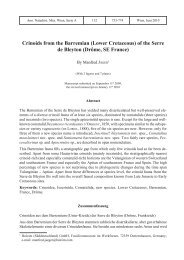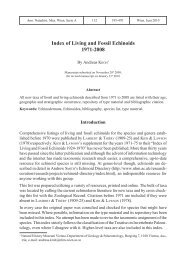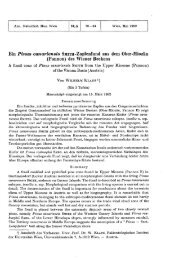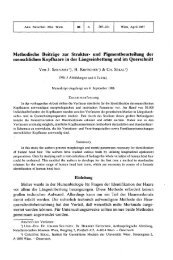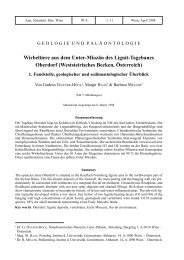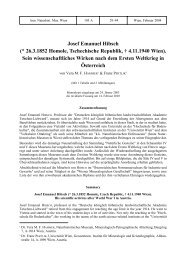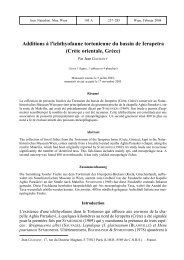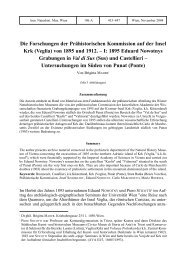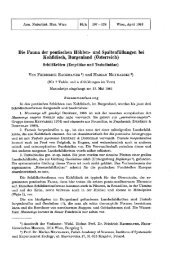An Upper Cretaceous Mollusc Fauna from the Marbles of ...
An Upper Cretaceous Mollusc Fauna from the Marbles of ...
An Upper Cretaceous Mollusc Fauna from the Marbles of ...
You also want an ePaper? Increase the reach of your titles
YUMPU automatically turns print PDFs into web optimized ePapers that Google loves.
110 G. CH. KATSIKATSOS & H. A. KOLLMANN<br />
& SiRNA (1971). From <strong>the</strong> figures given by GEMMELARO (1865), PARONA (1909), and<br />
CARBONE, PRATURLON & SIRNA (1971) it cannot be excluded that <strong>the</strong> two species fall<br />
within <strong>the</strong> variability <strong>of</strong> a single one.<br />
Nerinea jaekeli FUTTERER and Cossmannea edoardi CARBONE, PRATURLON &<br />
SIRNA (non PARONA) belong to <strong>the</strong> morphological group <strong>of</strong> Nerinea gemmifera,<br />
which always has a distinct angle between <strong>the</strong> palatal and <strong>the</strong> basal wall and a<br />
palatal plait close to <strong>the</strong> base.<br />
Occurrence: Nerinea edoardi PARONA is known <strong>from</strong> <strong>the</strong> Cenomanian <strong>of</strong> <strong>the</strong><br />
Monti d'Ocre, Italy. N. annulata is associated with Ichthyosarculites in Sicily and is<br />
<strong>the</strong>refore <strong>of</strong> Cenomanian age, too.<br />
Neoptyxis sp.<br />
(Plate 1, Figure 6-7)<br />
Material: 3 longitudinal sections.<br />
Description: Small whorls strongly concave, sides <strong>of</strong> larger ones approximately<br />
cylindrical. The following plaits are observable: 2 columellar plaits, lower one<br />
very distinct, at <strong>the</strong> external end strongly bent upwards, truncate. <strong>Upper</strong> columellar<br />
plait weak, acute, with thin base. Cross-section <strong>of</strong> inner parietal plait broad,<br />
external end slightly bent upwards, acute. Outer parietal plait very small. Palatal<br />
plait opposite to lower columellar plait, triangular, mostly not very prominent,<br />
only in one specimen strong and blunt. One flat, blunt plait on <strong>the</strong> base.<br />
Discussion: The pattern <strong>of</strong> internal plaits agrees with Neoptyxis PCELINTSEV<br />
(1934). Plesioptyxis PCELINTSEV (1953) is a junior synonym. Neoptyxis differs <strong>from</strong><br />
Plesioplocus PCELINTSEV by its more prominent upper columellar plait. A list <strong>of</strong><br />
species is given by HACOBJAN (1976).<br />
From Greece, N: incavata (BRONN) and N. symeonidisi have recently been<br />
described (KOLLMANN, 1982). While Neoptyxis symeonidisi has high whorls which<br />
are strongly concave, N. incavata has concave but low whorls. In contrast to <strong>the</strong>se<br />
species <strong>the</strong> whorls <strong>of</strong> <strong>the</strong> specimens described here are flat.<br />
Age: After HACOBJAN (1976) <strong>the</strong> stratigraphie range <strong>of</strong> Neoptyxis is Barremian<br />
to Turonian. According to his range chart <strong>the</strong> genus does not occur higher<br />
than in <strong>the</strong> Lower Turonian. The Lower Turonian occurrences seem to be<br />
restricted to <strong>the</strong> sou<strong>the</strong>rn Soviet Union.<br />
Italoptygmatis aff. geinitzi (GOLDFUSS)<br />
(Plate 1, Figure 4-5)<br />
1841 - 44 - Nerinea Geinitzi GOLDFUSS, Petrefacta Germaniae, p. 47, pi. 177, fig. 8.<br />
1863 - Nerinea digitalis STOLICZKA in STUR, Siebenbürgen, p. 50, fig. 3.<br />
1874 - Nerinea Geinitzi GOLDFUSS - GEINITZ, Elbthalgebirge I, p. 265, pi. 53, fig. 7.<br />
1965 - Nerinea (Ptygmatis) schiosensis PIRONA - LUPU, Cherghes, p. 51, pi. 1, fig. 4.<br />
1965 - Nerinea (Ptygmatis) digitalis STOLICZKA - LUPU, p. 51, pi. 1, fig. 5.



